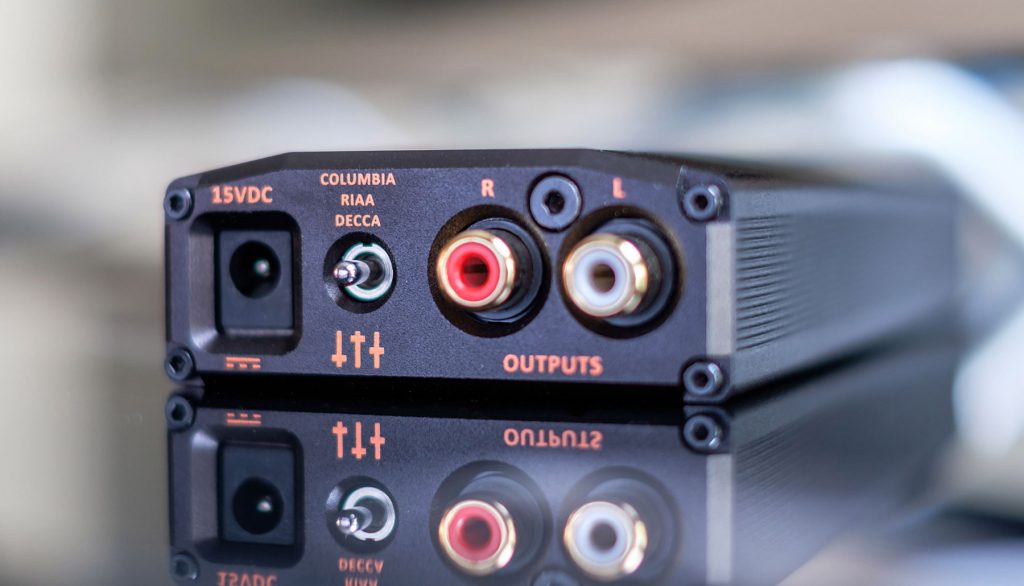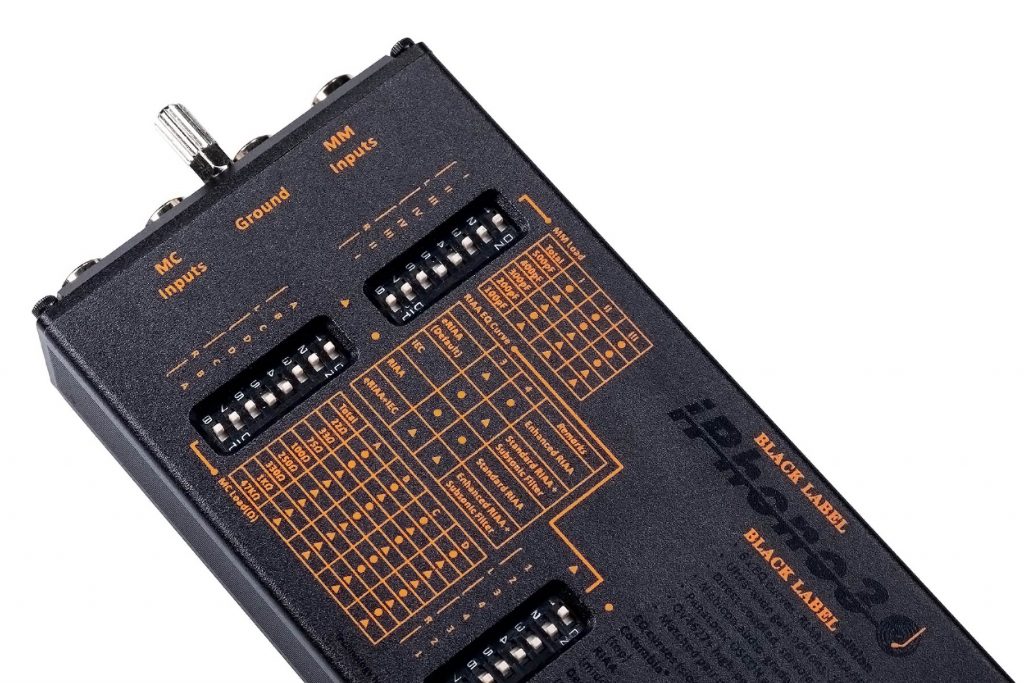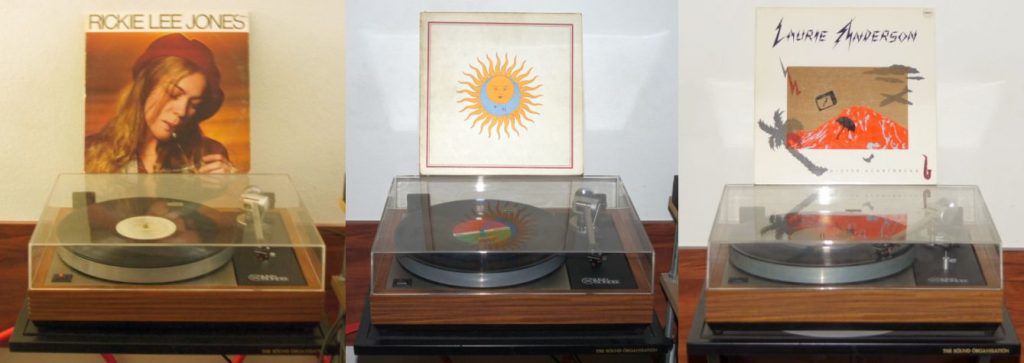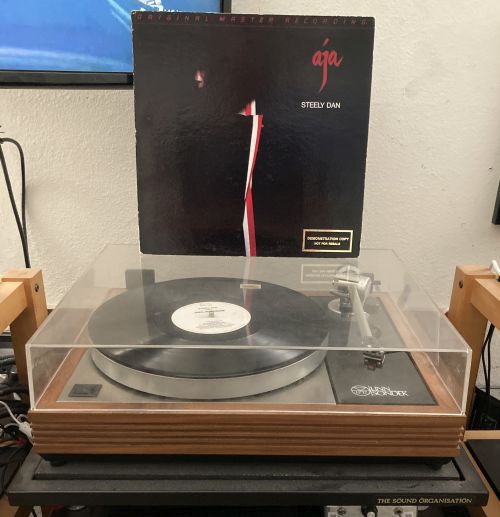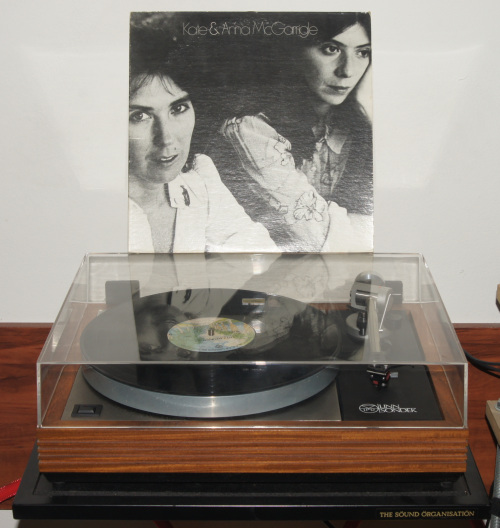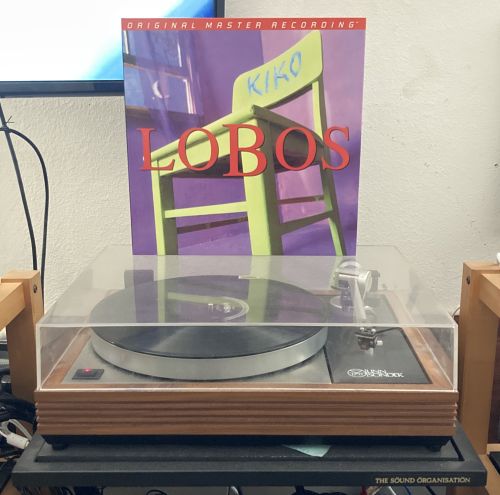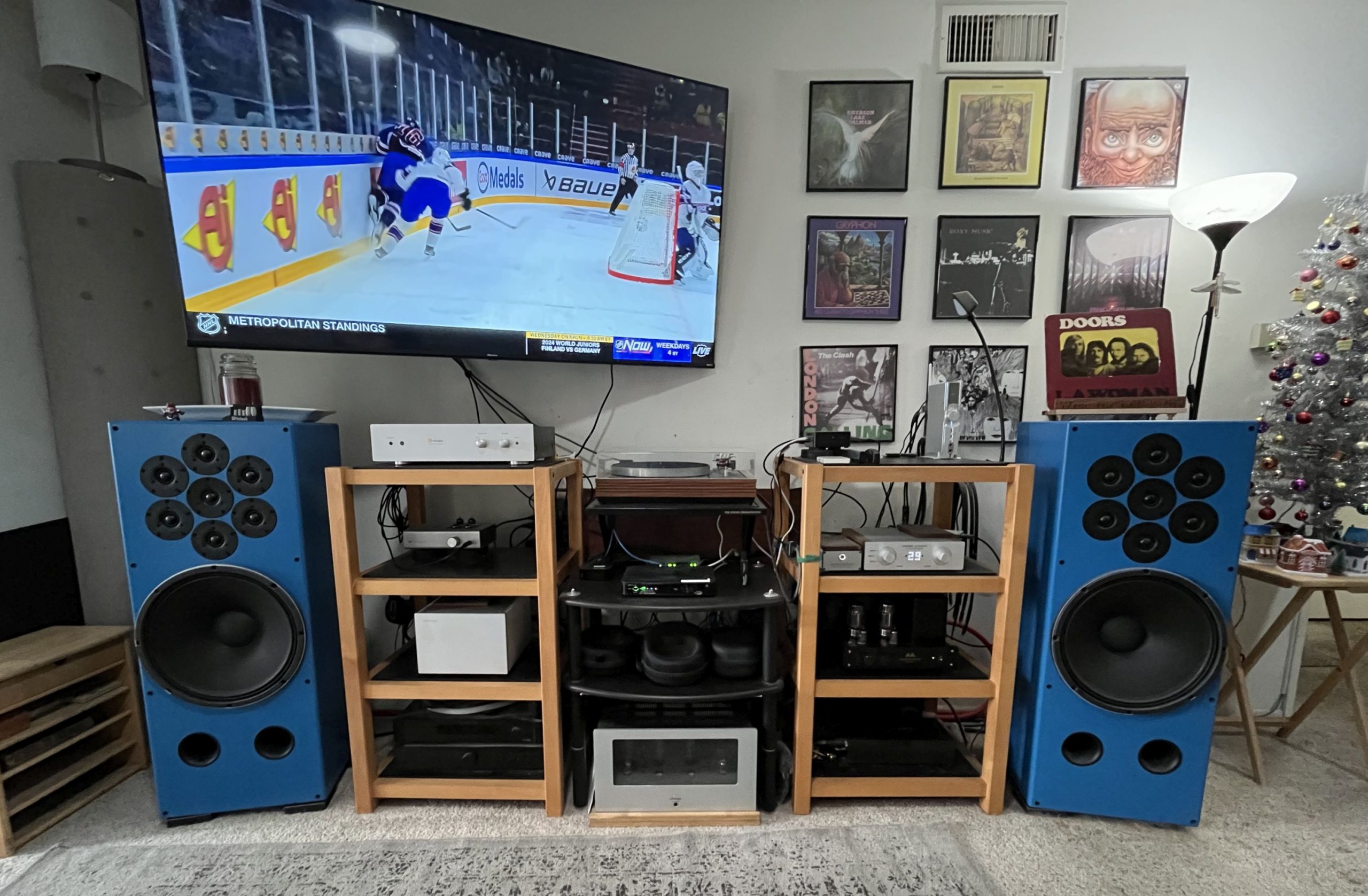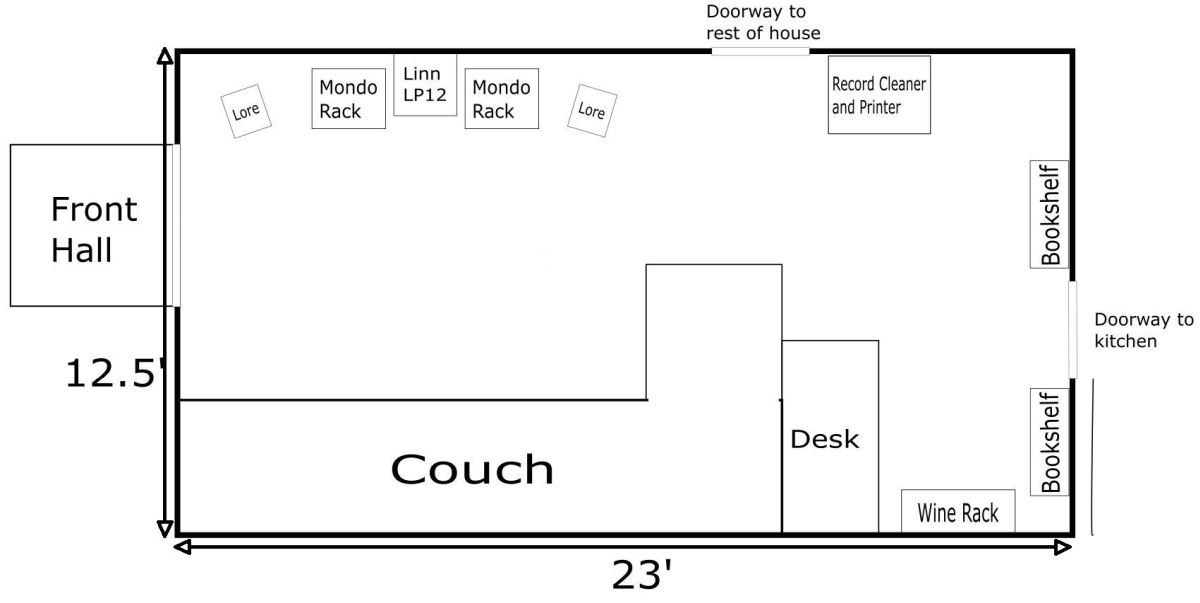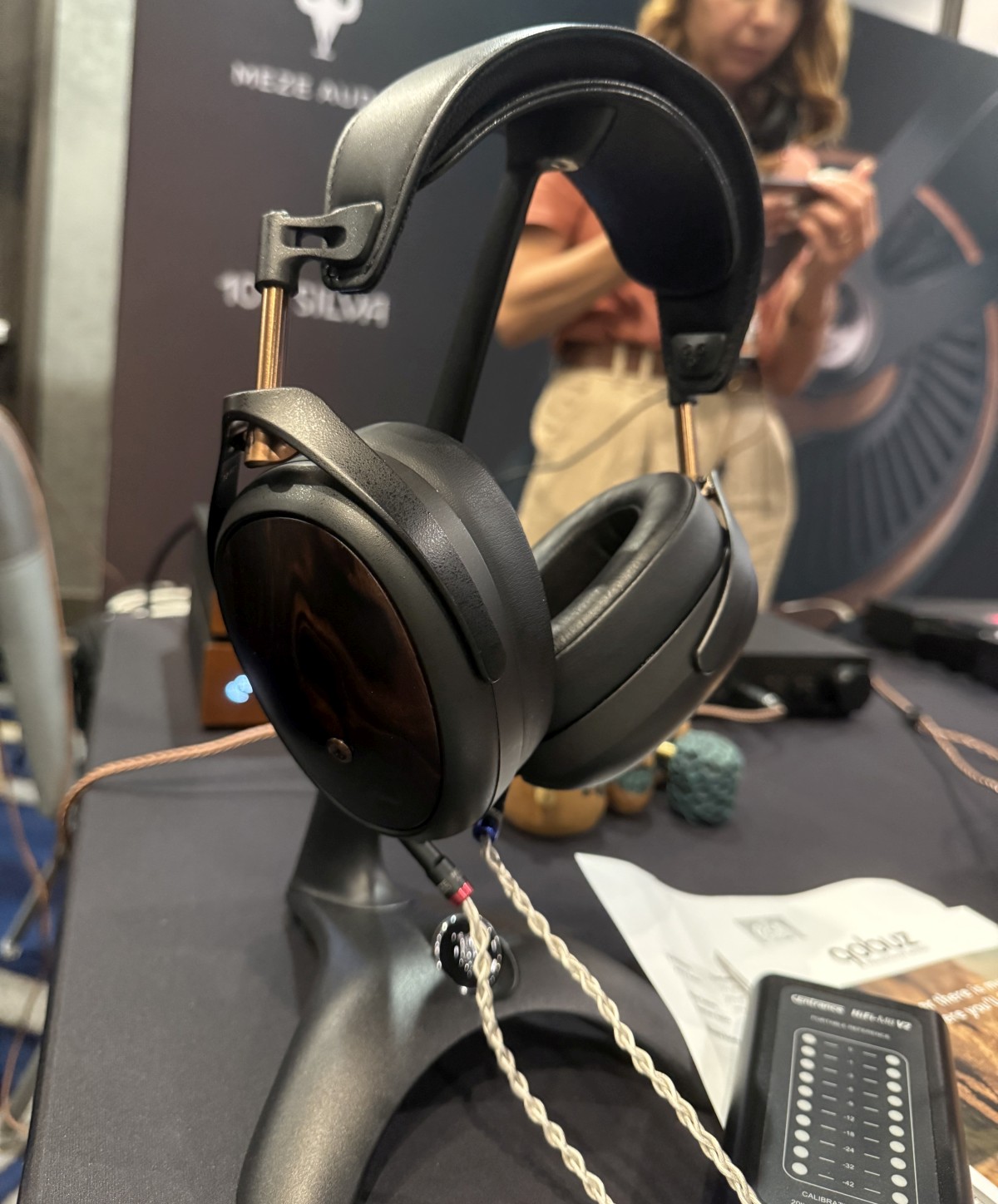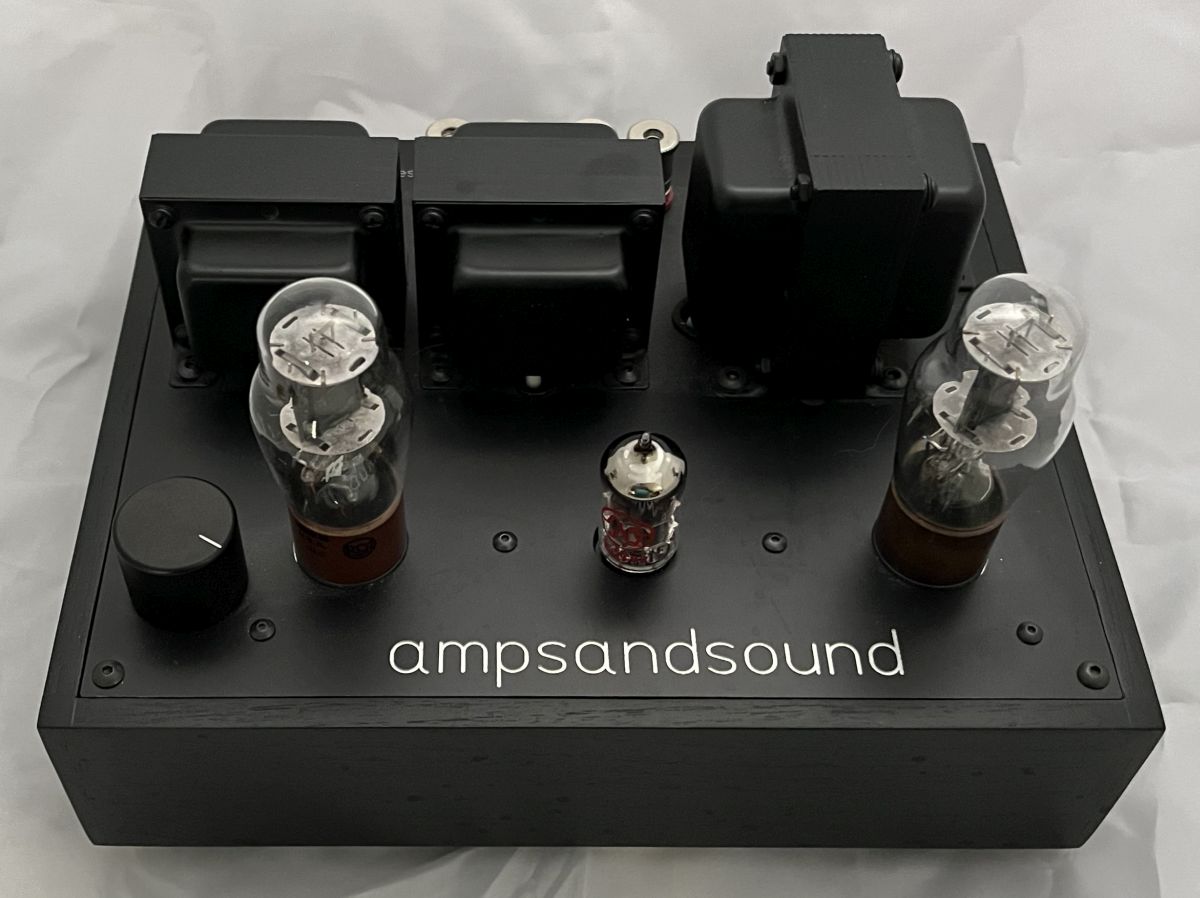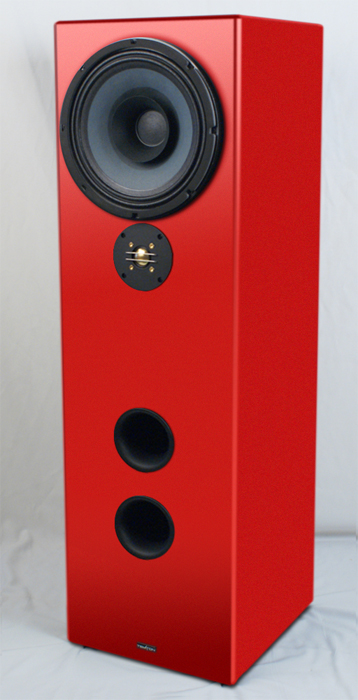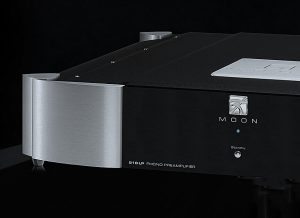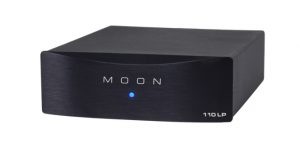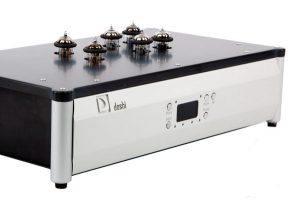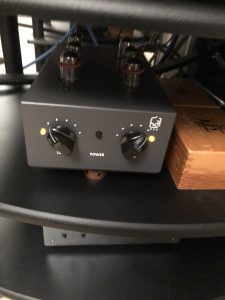I've had the same Linn LP12 turntable in my system for thirty-six years. Regular maintenance has kept it in tip-top condition. Of course it has had a few different cartridges over that time, but with one exception it is the same now as when I bought it in 1984. That one exception being replacing the original Valhalla power supply with a Mose / Hercules II power supply five years ago (documented HERE). It has even been used exclusively on the same Sound Organization wall mounted shelf for the past twenty-three years, having been on a Sound Organization floor stand prior to that. One benefit of having a piece of equipment in my system for that long, especially one in a critical source position, is that I am absolutely and intimately familiar with its sound. Anything that makes even the slightest change in the sound of LP playback in my system is quite easily and quickly discernible.
It also follows that no turntable, or table/arm/cartridge combination, can be heard outside of the effects of the phono stage being used to amplify its signal. To that end, for about thirty of those years I used the same PS Audio 4H preamp (always with the line stage switched out) due to its very nice and flexible phono stage. Initially, way back from about 1984 to 1986, I kept it loaded at 47K ohms since that was what they said to do in TAS, which I subscribed to back then. A chance meeting with Art Dudley at CES (we were both there for the delightful but short-lived magazine HiFi Heretic) he explained to me the necessity of proper loading for a moving-coil cartridge, which I promptly changed on returning home. The importer of the Talisman-S cartridge I used at the time recommended between 40 and 100 ohms. But I noticed I picked up some noise loaded that low. Setting the load to 1K ohm sounded noticeably better than 47K, so there it stayed. Same when I switch to a Dynavector cartridge some years later.
I've tried plenty of moderately priced phono preamps over the years, but always felt comfortable going back to my PS Audio. They got their start making an add on phono stage back in the day (the 1970s) when all preamps, integrated amps and receivers had built-in phono stages, so they seemed to know what they were doing.
In 2014 I received an iFi iPhono, unrequested. It just arrived. I tried it out, and quickly realized it clearly surpassed my now 30 years old PS Audio in almost every way. It had a noticeably lower noise floor even when set for higher gain and a 330-ohm load. I heard far higher resolution, better, more natural imaging. Something that surprised me, I heard much more impact, clarity and improved tone in bass response. Add in a far superior, clearer, airier and more convincing top end, and the original iPhono established itself as my everyday phono preamp. For $399 it was a steal.
Then in 2016, the iPhono was replaced by the iPhono2. Some internal circuit changes, improved quality parts, and a step up to 15-volt power supply instead of 9 volts seemed to produce a nice upgrade in sound. It was again, one of those subtle-but-significant upgrades where everything was a little bit better. Even the wall wart included with the iPhono2 was available as a $50 upgrade for other devices. The increase in price to $549 seemed reasonable, and the iPhono2 remained an easy recommendation. I've lived with the iPhono2 as my daily phono stage with my Linn LP12 ever since, while moving the original iPhono to work with the moving-magnet cartridge on a Pro-Ject RPM-1 Carbon. The system has sounded really nice ever since.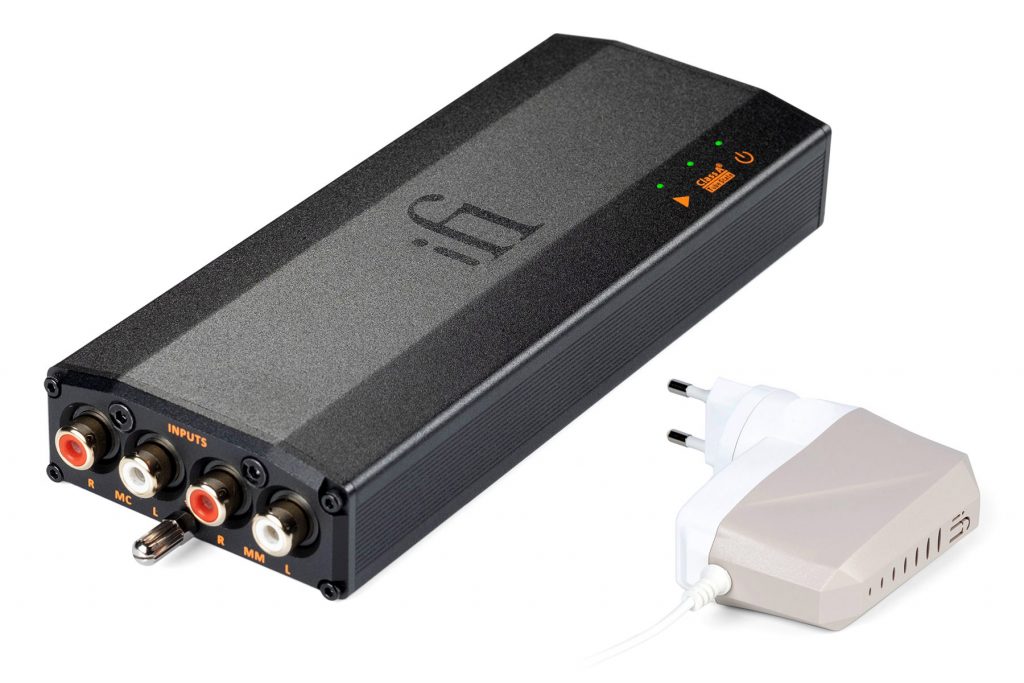
So now the iPhono3 Black Label has come out. Still generally looking just like the two previous models, with the obvious exception of the black color. They claim a substantial improvement over the iPhono2, again with improved circuitry and parts quality; "…. only the best audiophile components. Computer matched op-amps, high-gain bi-polar output transistors to Nichicon audio-grade capacitors. And much more" as stated in their literature:
- Dynamic range improved by 5dB to 108dB (36-72dB gain).
- 85dB A-weighted SNR is 3dB quieter (re 0.5mV/5mV per Stereophile standard)
- The increase in the power-supply voltage of the external iPower X ultra-low noise adapter for iPhono3 Black Label to 15V allowed for greater undistorted signal levels for LPs like the legendary (and often unplayable) Telarc 1812.
One other factor that may be of interest is that iFi's Direct Drive Servoless® design. Again, from their literature: Direct Drive Servoless® is an important element of the audiophile experience, which is not visible in measurements but is quite audible. Unlike a standard phono stage design, the iPhono3 Black Label continues the special design tradition of being direct coupled (i.e. no coupling capacitor) from cartridge to output and it does so without requiring a conventional DC servo.
However, this time there is a substantial price increase to $999.99. Fortunately, that price does include their new $100 power supply, the iPowerX. I'll have more to say on that separately later.
Like the previous version of iFi's phono stages, the iPhono3 is an extremely versatile unit. One feature that is unique in this price range is the ability to quickly choose between three different phono equalization curves, and with six different curves available. Those equalization curves are:
- RIAA
- eRIAA
- IEC
- RIAA+IEC
- Decca
- Columbia
Choosing between RIAA, eRIAA and IEC is done via DIP Switches on the bottom of the case. I tried RIAA and eRIAA and settled on standard RIAA for the bulk of my listening. Probably 99% of my listening during this review was done on the standard RIAA curve.
Once that is set, there is a small front panel toggle switch that allows you to quickly switch between the curve you set via DIP Switches (RIAA in my case), and either Decca or Columbia curves. On those rare occasions I pulled a 1950s era Columbia LP to play, I switched between both RIAA and Columbia curves to hear the difference. Maybe I am looking at it the wrong way, but I found the EQ switch useful as a tone control. If the LP was a little bright on RIAA, switching to the Columbia curve would tame that a little. Have to say though, that most of my 1950s Columbia LPs are far from mint, so maybe other issues (surface noise, general wear and tear, etc.) overwhelmed the differences in the curves.
From the bit of research I did on this (just a quick Google search, actually) it looks like Columbia records switched to RIAA curves in 1958. Same with the Decca curve. I don't have a lot of early 50s Decca LPs, most of my classical Deccas seem to be from the early 60s or later. If you have a large collection of early, especially mono Colombia and Decca LPs, this may be a very valuable feature. According to Michael Fremer at Analog Planet (Oct 4, 2014), all stereo Columbia and Decca LPs were done with the RIAA curves.
But the iPhono3 offers even more adjustability, all of which being very useful and well thought out. There are DIP switches on the bottom for setting gain, MC cartridge loading, and MM capacitance. They even offer a nice calculator on the website on how to set the DIP switches based on your cartridge specs (HERE).
For adjusting gain, you have a few choices. If you go in through the MM input, you start with 36dB of gain, and you get 60dB through the MC input. There is a +12dB DIP switch that increases these to 48 and 72dB respectively. With my old but trusty Dynavector 19a MC cartridge being rated at 0.2 mV output, I went straight for the 72dB setting. For comparison the original iPhono could adjust over a range of 40 to 66dB gain. It was impressive that with the gain setting at 72dB and my Burson Conductor Virtuoso preamp turned up all the way, any background noise through my 98dB sensitive Tekton Lores was inaudible at any distance more than about six to ten inches away from the tweeter.
When I tried the iPhono3 with a Pro-Ject RPM-1 Carbon and its Sumiko Pearl cartridge, I went in through the MM inputs and the +12dB switch off for 36dB gain. That was more than enough for the 4 mV rated Pearl. From a standpoint of gain, I think this unit will cover most any cartridge anyone would likely mate up with it.
For the moving magnet cartridge, the iPhone3 has adjustable capacitance, with values of 100, 200, 300, 400, or 500 pF. I used 100 pF for the Pearl.
For MC loading, there are more DIP switched for setting values of 33, 100, 330 or 1K ohms. You can use more than one switch in the on position to get values as low as 23 ohms (all four in the ON position) or in various combinations to as high a 1K Ohm. If you leave all four switches off, you get 47K ohms. Once again, as I did with the previous models from iFi, I used 330 ohms for my Dynavector.
One thing to keep in mind is that even though the iPhono series has two different inputs labelled MM and MC, after the initial base gain level, they share the rest of the signal path. That means you can't connect to both at the same time. Both inputs are always on and would both have the same settings for the subsequent DIP switches. That is why I use two separate iPhono units in my system. It would be interesting to try RCA shorting plugs in the unused input to see if that makes a difference, but I didn't have a set available to try.
There is no on/off switch. When you plug the power supply in it turns on. Its power consumption is listed as "< 5 Watts" so only the most energy conscious among us need be concerned. There are three really little LEDs on the iPhono3, one to indicate power on, one to indicate it is ready to operate, and the third one to show it is running in "Class A Tube State" which is something you can read about on their web site. As long as it remained plugged in and powered up, all three LEDs were on. Fortunately, they are not very bright and so remain unobtrusive even in a low light environment.
After unpacking and setting the new iPhono3 Black Label up in my system, I let it warm up for 36 hours before plugging my table into it. Over the years I've noticed that, though some solid-state gear needs a long break-in period while others don't, pretty much all of them need to be fully warmed up before they sound right. All the solid-state gear in my system stays powered up all the time and ready to use. I guess that's one reason I've stayed away from big Class-A power amps.
Anyway, it was time to try it out.
Mind you at this time I wasn't using my $5000 worth of Burson preamp and power amp. For another article I'm working on I was running my system with a $399 Emotiva TA-100 integrated amp. It has two line-level inputs so I had the iPhono3 in one and the iPhono2 in the other, allowing to quickly switch back and forth by simply moving the cable coming from my turntable.
I connected the Linn, verified there were no undue noises, hum or anything else coming out of my speakers and dropped the need on one of my favorite LPs; Samantha Crain's Under Branch & Thorn & Tree.
After about thirty seconds I had to stop. I needed to listen again with the iPhono2 first. Why? It just sounded so different through the iPhono3. There was a sense power in bottom end that I'd never heard from this LP before. Sure, it's a great all-analog recording with superb production across the board. But still…
Tried again with the iPhono2. Sounded beautiful, just like it always did. Switched back to the iPhono3 and, what can I say, it was like I was listening to a different pressing. I listened to the entirety of the first side twice, once through each phono stage. It wasn't just the bass, the iPhono3 was getting more of everything off that LP. It was like comparing a standard issue LP vs a super audiophile quality 180-gram edition.
I listened to a few more long-time favorites (Rickie Lee Jones first LP, King Crimson's Larks' Tongues in Aspic and Laurie Anderson's Mister Heartbreak) through both phono stages, and then shut the system down for the night. The first impressions I had of large wholesale improvements in sound quality were consistent across all three albums.
I removed the Emotiva, plugged my Burson gear back in, and figured I'd let it warm up for twelve to sixteen hours before trying again.
Over the next several weeks I dove into my record collection, but I'll admit, more than I usually do when reviewing a product, I tended towards a small number of favorite records that I was most familiar with over a long period of time.
I have a pre-prelease promotional copy of the MFSL reissue of Steely Dan's Aja. I know not everyone likes the MFSL reissue this LP, and it does sound like they tipped up the higher frequencies a little to add some sparkle, but every time I've compared this to any other version, it does sound a little more transparent and a little more dynamic. I've had this LP for many years and like it a lot. Playing this through both the iPhono2 and 3, the differences weren't as subtle as I had expected. Right from the opening notes of "Black Cow" the iPhono3 just had more punch.
But the subtleties were there too. In the title track when the marimba first joins in (around 30 seconds) though it is not prominent in the mix, it was much clearer as compared to then played through the iPhono2. Wayne Shorter's sax solo had more bite and grit to it.
Moving on to another old time favorite of mine. On the McGarrigle Sisters' eponymous first LP there is one track that always has an emotional impact on me, and whether mentioned or not, is always part of every review I do. I'm not necessarily looking for an objective change in sound, but I look for a change in the extent this track moves me. The track "Talk to Me of Mendocino" maybe means more to me because I too did the trek from New York State to California, and like the lyrics state:
I bid farewell to the state of ol' New York
My home away from home
In the state of New York I came of age
When first I started roaming
And the trees grow high in New York state
And they shine like gold in Autumn
Never had the blues from whence I came
But in New York state I caught 'em
And later:
Rise up over the Rockies and down on into California
Out to where but the rocks remain
And let the sun set on the ocean
I will watch it from the shore
Let the sun rise over the redwoods
I'll rise with it till I rise no more
You just have to hear them sing it. The way it sounded during this test I wish I could get it on a 12-inch single. I've never heard Anna's high harmony over Kate's lead sound so perfect. It brought both chills and tears.
Moving on to the MFSL reissue of Los Lobos' Kiko next I was treated to more of the same. Again, right from the start, the clarity of the drum kit and the effortless sense of dynamics in the vocals had me hooked. and The clarity and transparency on the title track was stunning. The power of the bass guitar and kick drum once again proved impeccable.
For checking out the ability to separate out individual instruments in a complex track, I turned to another old favorite, King Crimson's much underrated LP, Islands. The instrumental track "The Sailor's Tale" is insanely complex but a good system (and good individual pieces of equipment) can sort it out. Sorting out the multi-tracked Mellotron, guitar and sax while not losing out on the very well recorded drum kit is simply not easy. Again, comparing the iPhono2 and iPhono3 on this track, was quite impressive. Though I hadn't heard anything wrong at all with how the 2 handled this track, with the 3 I could much more easily follow along with each instrument. They were much better separated, tonally and spatially.
The closing, title-track of the album "Islands" (the song) may be the prettiest song King Crimson ever released. It is also an amazing example of spatial cues and imaging characteristics. There was so much width, depth and physical presence to the soundstage of this track. It had always been well played by the iPhono2, but just everything stepped up a notch through the iPhono3.
I was interested in how much the addition of the iPowerX had on the sound I was getting, s I compared the two phono stages swapping out their power supplies. The iPower I use on my iPhono2 was a $50 option and definitely worth it at the time. The iPowerX (originally a $100 option, but now included with the iPhono3) definitely was an improvement. Though somewhat subtle, using the iPowerX on my iPhono2 got me hint of the improvements heard in the iPhono3. The already low background noise floor of the iPhono2 dropped slightly, notes came from a slightly clearer space. The system definitely sounded more powerful, more impactful. Using the older iPower with the iPhono3 did result is a loss of some the magic I was hearing. Everything seemed just a little diminished compared to using the iPowerX.
So, what does it all mean? The iPhono3 is definitely a significant step up from the iPhono2. Much more so actually than the iPhono2 was over the original iPhono. But here's my concern. The original iPhono at $399 was a steal, and as easy a recommendation as you could make. At $549 (a 38% increase), the improvements wrought in the iPhono2 still made it a bargain and an easy, best buy recommendation.
At $999, a rather large 82% price increase, it really makes this a whole new product, not just and "upgraded version" of the previous model. And though yes, it is a substantial improvement in sound quality, it now has to compete in a different segment. At $549 you could buy the iPhono2 and never even worry about what else was out there. At a thousand bucks, the iPhono3 is certainly a great phono stage and probably a great bargain, but now you have to consider what else is out there. How would it compare to any number of highly regarded phono stages in the $1000 to $1500 category?
I can only describe what I heard in my system, and I hope I got the point across that if you liked the iPhono2, this is major step up in sound quality. I really loved how the iPhono3 sounded in my system. Most likely when the COVID shutdown is over and business is back to normal I'll be looking to upgrade to it. For now, though I'll be getting an iPowerX to go along with my iPhono2.
Specifications
- Frequency Response: 10Hz – 100KHz (±0.3dB), 20Hz – 20kHz (±0.2dB)
- Dynamic Range: MM (36dB): > 108dB (A-weighted)
- MC (60dB): > 106dB (A-weighted)
- Signal-to-Noise Ratio: MM (36dB): > 85dB (A-weighted re. 5mV)
- MC (60dB): > 85dB (A-weighted re. 0.5mV)
- Overload Margin: MM (36dB): > 26dB (re. 5mV, @ 1% THD)
- MC (60dB): > 22dB (re 0.5mV, @ 1% THD)
- Crosstalk: <-71dB (1KHz)
- Maximum undistorted output: 7V (Load >= 600 Ohm, THD <=1%)
- Total Harmonic Distortion (THD): <0.005% (MM 36dB 1V out 600R Load)
- Output Impedance: <100Ω
- Input Voltage: AC 100 – 240V, 50/60Hz
- Power Consumption: < 5W. Use with iPower X (15v) do NOT use any other power supply.
- Dimensions: 6.2' x 2.3' x 1.1' / 158 x 58 x 28 mm
- Weight: 0.58 lbs. / 265 g
iPhono3 Black Label
Retail: $999 including the iPowerX power supply
iFi Audio




